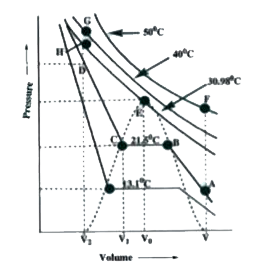P and Q are ideal gases which do not react with each other. The mass of one mole of P is four times that of Q. At STP, which of the following are true?Solution in Telugu
The average K.E of molecules of P is equal to that of Q
The mass of 1 dm3 of P is four times that of 1dm3 of Q
On mixing 1dm3 of P with 1dm3 of Q the partial pressure of each gas in the mixture will be 0.5 atm
The rate of diffusion of P is 4 times less than that of Q
Step by step video & image solution for P and Q are ideal gases which do not react with each other. The mass of one mole of P is four times that of Q. At STP, which of the following are true? by Chemistry experts to help you in doubts & scoring excellent marks in Class 12 exams.
Updated on:21/07/2023Topper's Solved these Questions
- STATES OF MATTER BOOK - AAKASH SERIESCHAPTER - STATES OF MATTER EXERCISE - ADDITIONAL PRACTICE EXERCISE (LEVEL-II LECTURE SHEET (ADVANCED)) (LINKED COMPREHENSION TYPE QUESTIONS) (PASSAGE-I)
3 Videos
- STATES OF MATTER BOOK - AAKASH SERIESCHAPTER - STATES OF MATTER EXERCISE - ADDITIONAL PRACTICE EXERCISE (LEVEL-II LECTURE SHEET (ADVANCED)) (LINKED COMPREHENSION TYPE QUESTIONS) (PASSAGE-II)
3 Videos
- STATES OF MATTER BOOK - AAKASH SERIESCHAPTER - STATES OF MATTER EXERCISE - ADDITIONAL PRACTICE EXERCISE (LEVEL-II LECTURE SHEET (ADVANCED))(STRAIGHT OBJECTIVE TYPE QUESTIONS)
8 Videos
- SOLUTIONS BOOK - AAKASH SERIESCHAPTER - SOLUTIONS EXERCISE - Objective Exercise -4
50 Videos
- STOICHIOMETRYBOOK - AAKASH SERIESCHAPTER - STOICHIOMETRYEXERCISE - PRACTICE SHEET (ADVANCED) (INTEGER TYPE QUESTION)
2 Videos
Similar Questions
Study the following isotherms of carbondioxide at various temperature and answer the following questions based on that:

Choose the temperature above which CO2 cannot be liquified whatsoever applied pressure is
View SolutionIn a various form of matter the constituent particles are held together with different types of forces. The extent of forces depends on the nature of the substances.
The forces operating in solid xenon are________
View SolutionHow many of the following have hydrogen bonding ?
HCHO,CH3OH,CH3COOH,CH3CHO,(CH3)2O,(CH3)3N,KHF2
View SolutionAssertion : Molarity of a solution decreases with an increase of temperature
Reason : As temperature increases volume of the solution increases.
View SolutionAmmonia is oxised by oxygen to give nitric oxide and water. The weight of water produced per gram of nitric oxide is 0.1×xg. What is value of d.
View SolutionIf each of the statements p→~q,~r→q and p are true then which of the following is NOT true ?
View Solution'P×Q' means 'P is son of Q'.
'P+Q' means 'P is daughter of Q'.
'P÷Q' means 'P is wife of Q'.
'P−Q' means 'P is father of Q'.
Which of the following relation is true with regard to expression 'B÷P×Z−K+O' ?
View Solution'PxxQ' means 'P is son of Q'. 'P+Q' means 'P is daughter of Q'. 'PdivQ' means 'P is wife of Q'. 'P-Q' means 'P is father of Q'. Which of the following relation is true with regard to expression 'B div P xx Z -K +O' ?
View SolutionIf p is true and q is false, then which of the following is not true?
View SolutionIf each of the statements p →~q,~r→q and p are true then which of the following is not true?
(A) q is false (B) r is true (C) r→q is false (D) r∧~q is false
View SolutionP and Q are ideal gases which do not react with each other. The mass of one mole of P is four times that of Q. At STP, which of the following are true?
View Solutionयदि p : प्रत्येक वर्ग एक आयत है q : प्रत्येक समचतुर्भुज एक पतंग है तो p→q तथा p↔q के सत्य मान क्रमशः ____ तथा ____ हैं
View SolutionIf each of the statements p→~q,~r→q and p are true then which of the following is NOT true ?
View SolutionWhich one of the following is not a contradiction? [~p∧(p∨~q)]∧q b. (~p∧q)∧p c. [(p(→)q)(→)p]∧~p d. (~q(→)~p)↔(p(→)q)
View SolutionIf each of the statements p→~q,~r→q and p are true then which of the following is NOT true ?
View SolutionThe table given below shows the mass number and number of neutrons in four elements P, Q To which groups do P, Q, R and S belong?
View Solution
